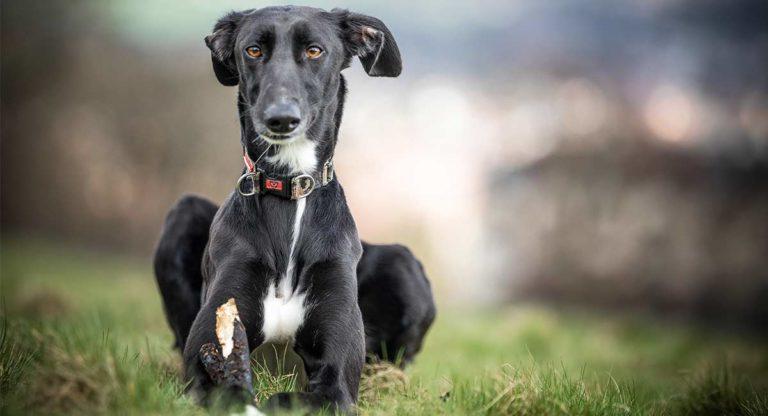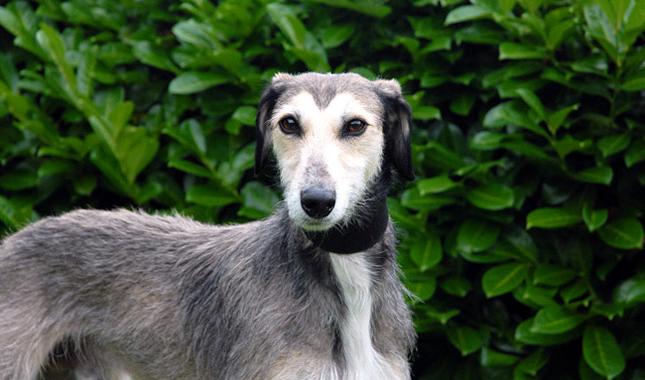- Breed Category: Sighthound crossbreed
- Country of Origin: United Kingdom
- Average Height: 56-71 cm (22-28 inches)
- Average Weight: 27-32 kg (60-70 pounds)
- Average Life Span: 12-15 years
- Grooming Requirements: Low to moderate
- Exercise Requirements: High, needs daily exercise
- Coat Type: Short, rough, or broken
- Coat Color Variations: Various, including brindle and black
- Shedding Level: Low to moderate
- Ear Type: V-shaped, semi-pricked
- Tail Type: Long and tapered
- Temperament: Gentle, affectionate, intelligent
- Intelligence Level: High
- Barking Tendency: Low
- Compatibility with Children: Good, generally friendly
- Compatibility with Other Pets: Varies, may chase small animals
- Training Ease: Moderate, can be independent
- Common Health Issues: Hip dysplasia, eye problems
- Dietary Needs: High-quality diet, moderate portions
- Energy Level: High
- Drooling Tendency: Low
- Sensitivity to Weather: Sensitive to cold
- Overall Maintenance Level: Moderate
- Original Purpose: Hunting and coursing
- Apartment Friendly: Yes, with sufficient exercise
- Best Suited For: Active families, rural settings
- Cost of Ownership: Moderate
- Unique Traits: Agile, fast, versatile
Imagine a dog that combines the speed of a Greyhound with the intelligence of a Collie. That’s the Lurcher for you. This unique breed isn’t just a mix; it’s a masterpiece of canine versatility. Originally bred for hunting, Lurchers are known for their agility and keen senses. They’re not a specific breed but rather a type, often a cross between a sighthound and a working dog. This gives them a unique blend of traits, making them both swift and smart. In this article, we’ll explore the Lurcher’s fascinating history, delve into their distinctive characteristics, and offer insights into their care. Whether you’re a seasoned dog owner or new to the world of canines, there’s something here for everyone.
History and Origin of the Lurcher Breed

Early Development of the Lurcher Breed
The Lurcher has a rich history that dates back to the British Isles, where it was first developed. This breed emerged from the need for a versatile hunting companion, combining the speed of sighthounds like Greyhounds with the intelligence and stamina of working dogs such as Collies. The result was a dog that could excel in various tasks, from hunting to herding.
Role in Hunting and Coursing
Lurchers were primarily bred for hunting and coursing, making them invaluable to hunters. Their keen eyesight and swift speed allowed them to chase down prey with remarkable efficiency. These dogs were often used to hunt rabbits and hares, showcasing their agility and quick reflexes. Their ability to adapt to different terrains made them a favourite among hunters across the countryside.
Key Historical Figures and Regions
The development of the Lurcher is closely tied to the rural communities of England, Scotland, and Ireland. These regions, with their vast landscapes and hunting traditions, played a significant role in shaping the breed. While no single historical figure is credited with their creation, the breed’s evolution was a collective effort by farmers and hunters who needed a reliable and versatile dog.
Physical Characteristics of the Lurcher

Appearance
Lurchers come in a variety of sizes, typically ranging from medium to large, depending on their parentage. Their coats can be short, rough, or even a mix, reflecting the diversity of breeds in their lineage. Colours vary widely, including shades of black, brindle, fawn, and more. Distinctive markings, such as white patches or unique patterns, add to their individual charm.
Unique Physical Traits
One of the standout features of Lurchers is their athletic build. They possess a lean, muscular frame that speaks to their heritage as hunting dogs. This build, combined with their long legs, gives them impressive speed and agility. Lurchers are known for their ability to sprint quickly, making them excellent companions for active individuals or families who enjoy outdoor activities.
Temperament and Behaviour of the Lurcher

Typical Personality Traits
Lurchers are known for their intelligence and adaptability. They can quickly learn new commands and adjust to different environments, making them a joy to train. Their energy levels can vary, but they generally enjoy a good run followed by a long nap. This balance of energy and calmness makes them versatile companions.
Suitability as a Family Pet and Working Dog
As family pets, Lurchers are affectionate and loyal. They form strong bonds with their human families and are known for their gentle nature. Their working dog heritage means they thrive when given a job to do, whether it’s agility training or simply playing fetch in the backyard. This dual capability makes them suitable for both family life and more active roles.
Interaction with Children and Other Animals
Lurchers generally get along well with children, displaying patience and a gentle demeanour. However, their sighthound instincts mean they might chase smaller animals, so early socialisation is key. With proper training, they can coexist peacefully with other pets, making them a harmonious addition to multi-pet households.
Training and Exercise Needs of the Lurcher

Importance of Early Training and Socialisation
Getting a Lurcher off to a good start with early training and socialisation is crucial. These dogs are smart and eager to learn, but they need guidance to channel their energy and instincts positively. Introducing them to different environments, people, and other animals early on helps them grow into well-rounded adults. This early exposure can prevent behavioural issues and make them more adaptable to various situations.
Recommended Training Techniques
When it comes to training, positive reinforcement is the way to go. Lurchers respond well to treats, praise, and play as rewards. Consistency is key, so regular short training sessions work best. They enjoy mental challenges, so incorporating puzzle toys or agility courses can keep them engaged. Remember, patience and a gentle approach will yield the best results with these sensitive dogs.
Daily Exercise Requirements and Activities They Enjoy
Lurchers are active dogs that need daily exercise to stay happy and healthy. A good run or a long walk is essential, but they also love activities that stimulate their minds. Fetch, agility training, or even a game of hide and seek can be great fun for them. While they enjoy bursts of activity, they also appreciate downtime, making them perfect for families who enjoy both active and relaxed lifestyles.
Health and Lifespan of the Lurcher

Common Health Issues
Lurchers, like many breeds, can face specific health challenges. They are generally healthy, but some may experience issues like hip dysplasia or heart conditions. Their deep chests make them prone to bloat, a serious condition that requires immediate attention. Regular vet check-ups can help catch these issues early.
Average Lifespan and Health Tips
On average, Lurchers live between 12 to 15 years. To keep them healthy, a balanced diet and regular exercise are crucial. They thrive on a mix of physical activity and mental stimulation, so keep them engaged with varied activities. Regular grooming, especially for those with longer coats, helps maintain their skin and coat health.
Preventative Care Recommendations
- Schedule regular vet visits for vaccinations and health screenings.
- Maintain a healthy weight through a balanced diet and exercise.
- Brush their teeth regularly to prevent dental issues.
- Keep their ears clean to avoid infections.
- Provide joint supplements if recommended by your vet, especially for older dogs.
Grooming and Maintenance of the Lurcher
Coat Care and Grooming Routines
Lurchers have a variety of coat types, from short and sleek to rough and wiry. Regular grooming is essential to keep their coat healthy and looking its best. For short-haired Lurchers, a weekly brush will suffice to remove loose hair and dirt. Those with rough coats may need more frequent grooming to prevent matting and tangles. A good brush and occasional bath will keep them fresh and clean.
Shedding and Seasonal Grooming Tips
While Lurchers are not heavy shedders, they do experience seasonal shedding, particularly in spring and autumn. During these times, more frequent brushing can help manage the extra hair and keep your home tidy. A slicker brush or grooming mitt can be particularly effective in removing loose fur. Regular grooming not only helps with shedding but also strengthens the bond between you and your Lurcher.
Diet and Nutrition for Lurchers
Nutritional Needs for Optimal Health
Lurchers, with their athletic build and active lifestyle, need a diet rich in high-quality proteins and healthy fats. These nutrients support their muscle development and energy levels. A balanced diet with the right mix of vitamins and minerals is essential to keep their immune system strong and their coat shiny.
Foods to Include and Avoid
Include lean meats like chicken or turkey, along with fish for omega-3 fatty acids. Vegetables such as carrots and spinach provide essential vitamins. Avoid foods high in fillers, artificial additives, and excessive grains, as these can lead to digestive issues. Chocolate, onions, and grapes are toxic to dogs and should be strictly avoided.
Feeding Schedules and Portion Recommendations
Feeding your Lurcher twice a day is generally recommended. This helps maintain their energy levels and prevents overeating. Portion sizes depend on their age, weight, and activity level, so it’s best to consult with your vet for tailored advice. Always ensure fresh water is available to keep them hydrated.
Fun Facts and Trivia about Lurchers

Interesting Tidbits about the Breed
Lurchers are often referred to as the “poacher’s dog” due to their historical use in hunting without attracting attention. Their quiet nature and speed made them perfect for this role. Despite their hunting background, Lurchers are known for their gentle and affectionate temperament, making them excellent family pets.
Another fascinating fact is that Lurchers are not recognised as a distinct breed by major kennel clubs. Instead, they are celebrated for their diversity, with each Lurcher being unique in appearance and personality, depending on their parentage.
Famous Lurchers in Media or History
While Lurchers may not be as famous as some other breeds, they have made their mark in literature and film. In the classic novel “The Plague Dogs” by Richard Adams, a Lurcher named Snitter is one of the main characters, showcasing the breed’s intelligence and resilience. Additionally, Lurchers have appeared in various British films and TV shows, often depicted as loyal and clever companions.
Final Thoughts

The Lurcher is a remarkable blend of speed and intelligence. This versatile breed offers both the thrill of agility and the warmth of companionship. While they require commitment in terms of exercise and training, the rewards of owning a Lurcher are immense, from their affectionate nature to their adaptability. Embrace the unique journey of having a Lurcher, and you’ll find a loyal friend ready for any adventure. Consider adopting a Lurcher and experience the joy of this extraordinary canine companion.
